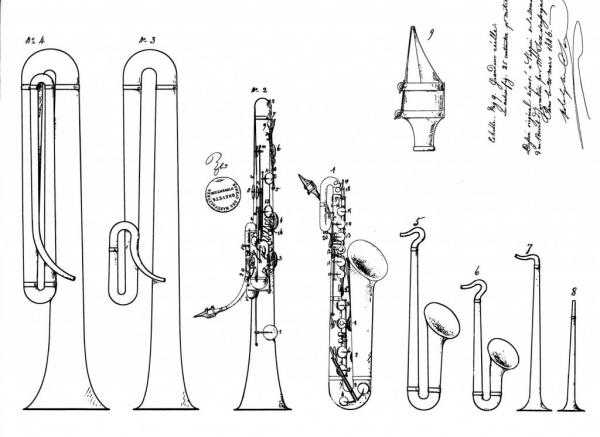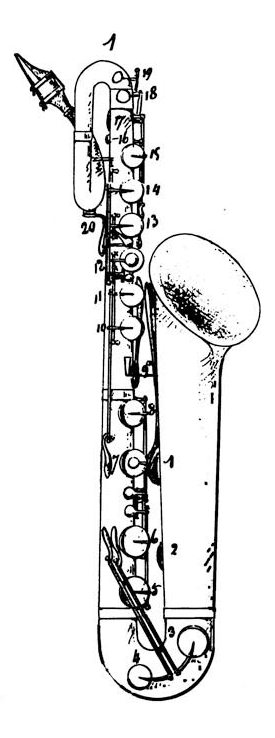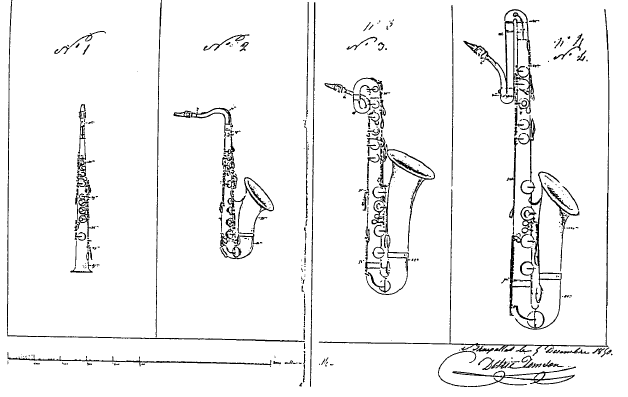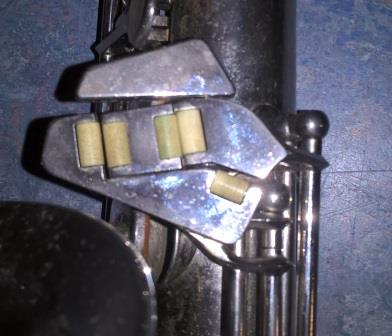The History of the saxophone
The first important moment in the saxophone history happened at the Brussels Industrial Exhibition of 1841, Adolphe Sax gave a first official demonstration of his latest creation: the saxophone (literal meaning = Sax's voice).
In the time of Adolphe Sax there were still various problems in orchestras with (wood) wind instruments. The instruments varied enormously in quality, tuning and loudness. With the possibilities of the instruments at that time there were gaps in the tonal range and there were especially in the low range. The basset horn and basson sounded too soft, for example. At that time, the Ophicleide was used, but it did not function well in the lowest range.
The sax is probably based on the Ophicleide, a metal bass instrument with a metal mouthpiece like a trumpet and keys like we know them from the saxophone today. The instrument is conical, but less strong than the saxophone and all keys rotate on their own axis and have their own key. The Ophicleide was made in the musical instrument factory of Adophe Sax's father.

Brass instead of wood
Adolphe Sax had decided that only an instrument with large tone holes and a rapidly widening bore could meet the requirements of that time. The body became conical and took on the shape of a parabola. As a result, the saxophone overblows by an octave like the oboe and not like the cylindrical clarinet. The conicity at that time was approximately 1.07.
The tone holes were too large to close with a finger, so keys and raised tone holes were needed to create a flat key..
Originally, woodwind instruments such as the oboe and the clarinet were made of boxwood. This type of wood is very fine and dense, but relatively sensitive to moisture and temperature changes. When the use of multiple keys became common in clarinets, the boxwood was replaced by tropical woods of better quality.
The size of the body and the size of the tone holes of the saxophone made wood a less suitable material for the instrument. The material was expensive and heavy and yet too sensitive to temperature and humidity. The use of brass was already known from the as ophicleides and was therefore obvious. The material of the body appeared to have little influence on the sound and had the advantage of being lighter in weight, greater strength and easy to work with. However, over the years the thickness of the material increased to provide more strength.
Keys and tone holes
For a very long time the tone holes of clarinets were limited to approximately 8. Semitones were made by fork grips. In addition, all tone holes were directly within reach of the fingers.
Following Boehm, Sax calculated the exact location of large tone holes for each semitone in order to realize a clear tone and pure range. He designed a key mechanism in which the keys were grouped on raised axes placed on posts. (in the Ophicleide each key had its own axis).
The Saxophone has a total of
- 20 tone holes of which 10 are closed at rest and 8 are open at rest
- 18 keys for operating the keys
- 6 keys for the left and right hand
- 3 left palm keys for the left hand for high D, D# and F
- 3 left pinky keys for the G#, the low B and low C#
- 2 right palm keys for the Ab and for the high E
- 2 right pinky keys for the D# and low C
- 2 octave keys for the thumb (closed at rest)
- A special feature was that not all keys were closed at rest, as with the Ophicleide, but often open at rest. The open tone holes under the tone hole that determines the pitch ensures an open and uniform sound over the entire range of the saxophone.
Reed and Mouthpiece
Due to the large initial diameter of the saxophone, a double reed as in the oboe was not usable and a single reed was used as in the clarinet. The mouthpiece was given a relatively large chamber proportional to the volume equal to that of the tip of the cone. Mouthpieces at that time were made of wood.
1846 Patented Saxophone
In 1846 Adolphe Sax patented the saxophone. The sketch below is from the patent. The patent shows 8 different sizes from sopranino to contrabass that have similar dimensions characteristics and operation. In addition 6 other patents such as the single reed mouthpiece.

Model 1 - was called an Eb-tenor by Sax (nowadays an Eb baritone.
Model 2 - a bass saxophone in C or Bb.
Model 3 - a contrabass in G or Ab
Model 4 - a subcontrabass in C or Bb
Models 5 to 8 - as 1 to 4 but an octave above model 1.
What is striking is that the shape of the saxophones does not yet correspond very much with that of the contemporary models. The Eb tenor (model 1) looks most like the Eb baritone of today. The necks of models 5 to 7 still look strange. The shape of models 1 to 3 still looks very much like that of an Ophicleide. Sax probably applied for the patent because of the competition before the other models had been developed and the patent mainly laid down the principles. Due to the attention for the improvement of the bass instruments, it was expected that the baritone sax would be the most important member of the saxophone family. Sax was the first to work out that design.
An enlargement of the sketch of the baritone is interesting. It shows all the typical characteristics of the sax of that time.

It shows the limited number of keys:
- 20 keys
- The low C and D# are beyond the lower curve
- The low B and C# key are at the back of the bell
- upward-facing mouthpiece
- octave key at the bottom of the swan neck
1850 Patent in Belgium
In 1850, Adolphe Sax applied for a saxophone patent in Belgium. The different versions more closely resemble the saxophones we know today. In his patent, Sax describes the alto, tenor, baritone and bass saxophone. The bass saxophone has changed significantly in shape. The body, which in 1846 still consisted of several parallel tubes, now has a straight tube, just like the baritone, on which all the keys are also attached.

improvements in the baritone compared to 1846:
- the neck has been adjusted so that the mouthpiece is more directly in front of the player
- the second octave key has been moved higher on the bow
- the bends in the neck are less sharp (reduces turbulence)
- the bell ends wider
- the low B key has been moved to the side of the bell and has an improved mechanism
Features of the saxophone of that time:
- a single reed on a wooden mouthpiece
- the lowest note is the low b
- no front F
- no side C
- no side F#
- wire-shaped key protectors
- cork bumper on the key protector
- b flat key only operated by right-hand key
- no side key for Ab
- side key for high E
- g# keyhole not in line with other keyholes but with separate direct keyhole on the side
- no coupling between G# and right-hand keys and low B, Bb and C#
- no coupling between B flat and right hand
- no automatic octave key but a double octave key
- no mother of pearl in keys
- no rollers in pinky keys
- two bends in the neck of the alto
- The low B flat key on the side of the be
Other important milstones
- 1856 - alto neck becomes straight and the bell becomes smaller
- 1881 - Adolphe Sax receives a patent for several improvements like the increase of the lengthe and addition of a low Bb and Low A
- 1888 -Lecompte receives a patent for the frist automatic octave mechanism
- 1902 - Evette Schaeffer launched the first saxophone with a front f
- 1914 - Hayes gets patent on drawn toneholes
- 1919 - the first saxophone appear with rolled toneholes
- 1926 - the American saxophones informally adopt 440Hz as a standard
Sources
Robert Howe, “Invention and Early Development of the Saxophone, 1840-55”. Journal of the American Musical Instrument Society 29:97-180, 2003. Reprints available from the author or at ebay, http://www.ebay.com/itm/-/131470538213.









